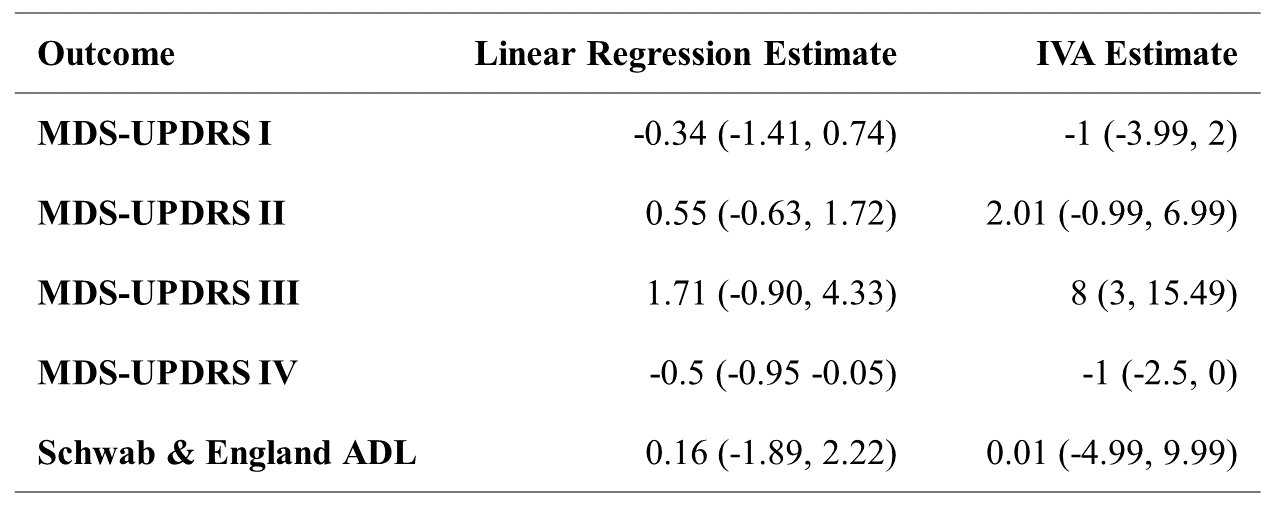Objective: To compare short-term levodopa and non-levodopa dopaminergic treatment response in people with Parkinson’s disease (PD) using instrumental variable analysis and linear regression.
Background: Treatment effect analyses using observational data are subject to unmeasured confounders including prescription drug coverage and comorbidities. We used nonparametric instrumental variable analysis (IVA) to account for unmeasured confounders and to determine whether first-line treatment with levodopa or non-levodopa dopaminergics (dopamine agonist and/or MAO-B inhibitors) showed improved outcomes at six months.
Method: 360 newly diagnosed, untreated Parkinson’s Progression Markers Initiative PD participants began motor treatment with levodopa (n=125), dopamine agonist (n=79), MAO-B inhibitor (n=129), or a combination of agonist/MAO-B inhibitor (n=27). Participants who had sufficient data and were at a study site that showed a preference toward either drug were used for treatment analysis. For IVA, participants were matched by baseline characteristics using propensity score matching (optmatch, R). Comparing “adjusted” outcomes between these groups is aimed at mimicking treatment comparisons in a randomized controlled trial. IVA results were then compared to linear regression.
Results: The average time to initiate treatment was 18.3 months (± 12.6) after diagnosis, with the first alteration 8-9 months later (± 0.5); 22 (6%) had no record of drug change. Linear regression and IVA provided different results for MDS-UPDRS III, and similar results for parts I, II, IV and Schwab & England ADL. IVA showed levodopa to be statistically superior for part III (-8 points, 95% CI 3, 15.49), but inferior for part IV (+1 point, 95% CI -2.5, 0). Linear regression only showed significance with part IV (+0.5 points, 95% CI -0.95, -0.05). There was no difference between levodopa and non-levodopa outcomes for ADL or parts I or II.
Conclusion: We found levodopa to be better at controlling motor symptoms in the first six months, though associated with an increase in motor complications. IVA is favorable in terms of decreasing bias due to unmeasured confounding compared with linear regression. Though IVA yields larger confidence intervals than linear regression, the results show a stronger drug effect with levodopa when taking into account unmeasured confounding. Future studies will focus on longer-term outcomes.
To cite this abstract in AMA style:
M. Javidnia, W. Artman, J. Jones, A. Ertefaie, C. Venuto. Accounting for unmeasured confounders in treatment response: a comparison of levodopa versus non-levodopa dopaminergic drugs [abstract]. Mov Disord. 2020; 35 (suppl 1). https://www.mdsabstracts.org/abstract/accounting-for-unmeasured-confounders-in-treatment-response-a-comparison-of-levodopa-versus-non-levodopa-dopaminergic-drugs/. Accessed December 16, 2025.« Back to MDS Virtual Congress 2020
MDS Abstracts - https://www.mdsabstracts.org/abstract/accounting-for-unmeasured-confounders-in-treatment-response-a-comparison-of-levodopa-versus-non-levodopa-dopaminergic-drugs/

